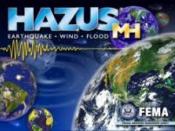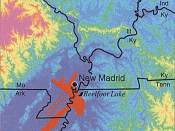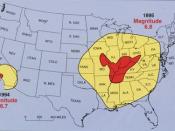Hazus is a FEMA sponsored program developed to help perform a damage analysis due to a disaster. Currently, Hazus is only capable of estimating losses due to earthquakes. FEMA is in the works of developing future software that will make Hazus capable of analyzing floods, tornadoes, and hurricanes.
Hazus uses probability to make loss estimates for various communities after a disaster is simulated. Census tracts for the community are required so that the Hazus can compute accurate loss estimates. There are numerous capabilities depending on the amount of information that is entered into the Hazus database. Our group looked at the damage analysis of Lafayette County and also Oxford, MS, which houses the Emergency Operating Center for the surrounding area. A magnitude 7.0 earthquake, with the epicenter being located at Marked Tree, AR was simulated. This location is at the southernmost point of the New Madrid fault line. Magnitudes of 6.0
and 8.0 were also simulated for means of comparing results. Summary reports from these two magnitudes are included with full summary reports of the 7.0 magnitude. As expected, wood constructed buildings would suffer the most damage if an earthquake were to take place. Unreinforced masonry would be next, followed by steel and concrete. The wood exposure is also probably the highest due to the fact that the majority of buildings in the county are wood construction. Looking at the damage by general occupancy report: for a 7.0 magnitude, Commercial buildings have a 73.8% of no damage, 15.4% of slight, 8.6% of moderate, and 2.2% of extensive damage. Educational buildings have 44.4% of no damage, 8.8% of slight, 5.4% of moderate and, 1% of extensive damage. Residential have an 82.4% of no damage, 11.2% chance of slight, 5.2% of moderate, and 0.4% chance of extensive damage. Finally, government buildings have a 73.8% of no damage, 14.8% of slight, 9.4% of moderate, and 1.6% chance of extensive damage. As shown, it is most likely that no damage will occur, but there is still good chances that slight to moderate damage could occur due to a magnitude 7.0 earthquake.
Looking at the hospital functionality report: 75% of beds would be occupied after 1 day, 78% after 2 days, and around 84% after 1 week of the disaster. As far as the emergency response facilities go, the EOC, fire department, and police departments would all be at around 75% functional. Transportation systems would be affected somewhat also. There is a 90% chance that highway bridges would suffer no damage, an 8% chance of slight damage, 1% chance of moderate to extensive damage, and a 0 % chance of complete damage. It has been estimated that 347 thousand dollars would be lost to highways.
Shelters will play an important role in the relief effort after the disaster. It is estimated that there will be around 25 displaced households and around 31 people needing short term shelter.
Looking at the summary report of economic losses to buildings: structural damage could reach as much as 3.2 million dollars, non-structural damage could be as much as 7.6 million dollars, and total losses for buildings in the county could reach as much as 20 million dollars.
From all of the summary reports generated by Hazus, it is clear to see that this program plays an important role in loss and damage estimations due to disasters. One day, Hazus could be the standard software that FEMA requires for the disbursement of federal disaster aid funds.
Hazus Summary Report CCCR Consultants





